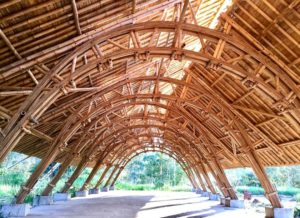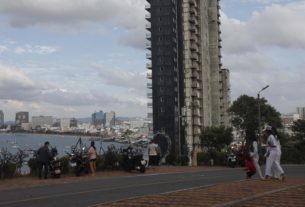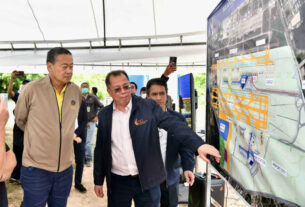
Myanmar ushering in a new era for bamboo buildings
29 April 2019
Easily obtainable from the jungle, bamboo has many uses, for household goods, roofs, walls and shelters dating back to ancient history. As a building material, it is affordable even for the poor.
Enter Ko Soe Win Zaw, a civil engineer born in Shan State, who is using bamboo to construct buildings for the rich.
The founder of Pounamu Bamboo Design and Construction, Ko Soe Win Zaw said, “Myanmar people have lived in bamboo huts for centuries. But bamboo is not durable, and traditional construction methods leave it vulnerable to being destroyed by pests.”
However, by using modern technology, bamboo has entered a new era in which it is being used for durable luxury buildings.
Getting started
It has been about three years since Ko Soe Win Zaw set up his company to construct bamboo buildings at eco-resorts, eco-villages and private homes. Pounamu Bamboo Design and Construct also conducts workshops on construction using bamboo.
The firm is now working on a resort in Myeik township, Tanintharyi Region, which uses bamboo in its interior. Together with UKAid, it is building a new training hall on Kadan Island in Myeik as well as a community hall in a remote village in Dawei township.
The company is also working on a prototype of an affordable single-family home made from bamboo with the Association of Myanmar Architects in Kankaung village, Nyaungshwe township, Shan State, where its bamboo treatment factory is located.
“At the beginning, I was uncertain how to build using bamboo,” said Ko Soe Win Zaw. However, with the help of friends, he had a chance to learn how to use bamboo and its processing and treatment in neighbouring countries.
When he arrived at Green School in Indonesia’s Bali, he was astonished to see stunning buildings built with bamboo in layers, and he got the idea to build creative designs when he returned to Myanmar.
“Since then, I couldn’t help thinking about bamboo and set up this company,” he said.
Good prospects
Ko Soe Win Zaw sees good prospects for bamboo construction. Promoting this industry could benefit tourism as well as environmental conservation and people living in rural areas, he said.
Bamboo is flexible, durable and light, which is proved by its use as scaffolding for a very long time.
The recent surge in public interest in things close to nature, with more people preferring bamboo structures to concrete buildings, gives him hope for the future of bamboo.

He said hoteliers are mostly interested in bamboo buildings, accounting for 90 percent of his business, although people in other fields are interested as well.
Trust issues
Despite its rosy prospects, people have less trust in bamboo buildings because they have seen such buildings fall into disrepair in a short time.
To prove that bamboo can be durable, the first long-lasting bamboo monastery was built and donated in Hopone, Shan State.
Using modern technology durable buildings made from bamboo are possible, as shown by the Village Hall in Kyike Pe Lan village in Dawei, Tanintharyi. Bamboo buildings are also being built in Pyin Oo Lwin in Mandalay Region, Lashio in Shan, and in some islands in Kawthoung, Tanintharyi.
It’s not easy to get quality bamboo to construct bamboo buildings. Raw bamboo must first be cleaned and treated in tanks that hold 30-40 bamboo, and then dried in the sun for a week or 10 days, which hardens the bamboo. It takes a matter of months to construct a building, Ko Soe Win Zaw said.
Luxury bamboo houses are priced depending on their design, he said, so it is hard to tell the exact cost of a house.
Supply chain challenge
Though interest is rising in bamboo buildings, he faces difficulties getting good quality raw bamboo, Ko Soe Win Zaw said.
“Some just cut the bamboo without care, so if we buy 300 bamboo plants, we are able to use only around 100, and we have to try to think of other ways to use the rest,” he said.
According to the Forest Department, most of the country’s bamboo forests are in the Pegu Range, Rakhine State, and Tanintharyi. There are around 1250 bamboo species around the world, of which Myanmar has around 100, but there are only 18 commercially viable species.
To ensure a supply of high-quality bamboo, Ko Soe Win Zaw said, he shares best practices in growing and cutting bamboo forests with local villagers.
Although more people are growing bamboo each year, most of it is still harvested from forests, he said.
Another difficulty is transporting the bamboo. Forest products are allowed to be used only with the permission of the Forest Department, and if delays occur during transportation, it can cause losses in constructing durable buildings. Timing is crucial, as it is an industry that depends on the weather, he said.
“We are scrutinised when we transport bamboo. We need a permit to transport between towns. We are happy to pay taxes, but the problem is we have to pay other charges. We pay K200,000 to the government, but there are other costs,” Ko Soe Win Zaw said.
“Bamboo plants must be felled when it is the right time. The suppliers fell them when they are four or five years old. They need to be clean,” he said.
The cutting, buying and treatment of bamboo have to stop during the rainy season.
On balance though, experts believe the opportunities outweigh the challenges for Myanmar bamboo.
Bamboo absorbs more water than trees and can improve the quality of the soil and water. It protects against land erosion and can be useful as wind shields, environmentalists say.
Meanwhile, with the right regulation and support, the industry has the potential to grow beyond Myanmar.
“Myanmar people are already familiar with bamboo. We can grow systematically. If advanced technologies are available, nothing can stop Myanmar bamboo from reaching the international market. We just need to appreciate the value of our raw bamboo,” according to Daw Daisy Thantzin, environmentalist and founder of the Bamboo Lovers Association, in the book “Wa Wor Worr, or Green Gold.”
Source: https://www.mmtimes.com/news/ushering-new-era-bamboo-buildings.html


